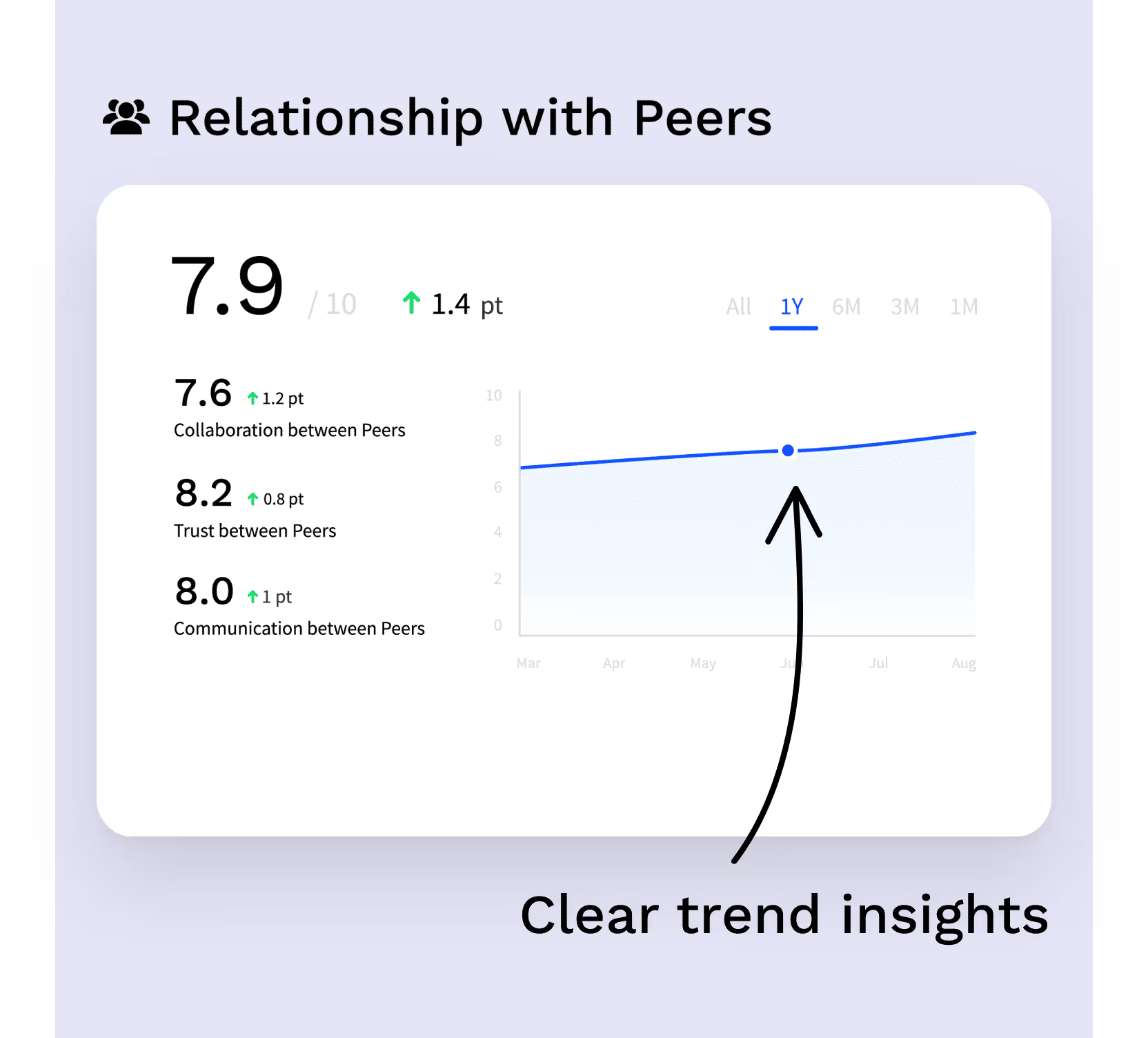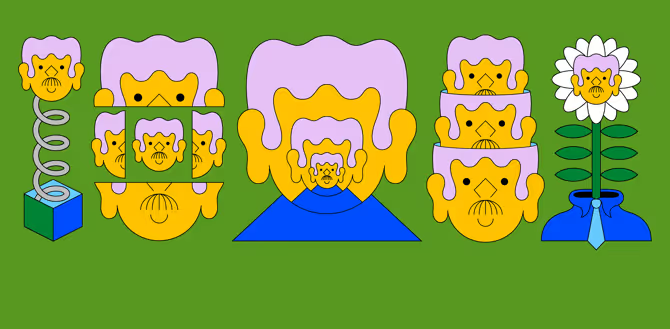Building relationships at work: How to maintain connection across remote teams

Discover Workleap Officevibe's benchmark report on 12 key employee engagement metrics

For decades, physical presence and positive work environments have been central to building relationships at work. The shift to remote work mixes things up. There's no more water cooler chatter or desk buddies to bond with. This can adversely affect our ability to truly connect with our colleagues.
Yet, can you imagine that brand new teams are forming and meeting for the first time over Zoom? We are living in the future of work. Our current team consists of 4 people who have never met in real life. In a way, we are strangers, so we have to be intentional about building trust with our employees and we can’t take for granted that it might be a bit harder than usual.
Managers: it’s important to be aware of the ways that working remotely can strain team and workplace relationships. We’d like to offer tips to help your team connect on a human level, even from afar.
Positive workplace relationships are key to team success
Perhaps no factor is more important to team engagement and retention, than relationship building.
As per Gallup’s 2017 State of the American Workplace Report, dissatisfaction with one’s manager is one of the 6 most common reasons why employees leave a job. Maintaining a positive rapport with your team will be crucial not only for their performance but their retention.
{emphasize}
90% of employees who use Officevibe trust their direct manager.
{emphasize}
Likewise, people who report having friends at work are happier and more performing. It makes sense; we spend 40 hours a week (on average) with coworkers, so connecting with them can make or break our success. After all, success comes from functioning as a team, not as an individual.
How relationships contribute to team success:
{emphasize}
Collaboration depends on how comfortable people are with one another People are most engaged at work when they see colleagues as friends Positive relationships help teams have successful difficult conversations Respectful workplace relationships contribute to inclusion at work When people trust their peers, it's easier to admit to mistakes and learn
{emphasize}
How has remote work affected our relationships?
How many of you have been eating lunch alone since going remote? It wasn't always this way. Think of the times we used to spend chatting with our colleagues and enjoying social interaction. These moments of sporadic connection not only kept employees engaged and bolster weak ties (such as those across departments), they led to discussion that can generate spur of the moment ideas. Here are some more ways remote work might affect meaningful relationship building at work.
Decreased connection and collaboration
Group cooperation can falter when the group is dispersed. Often it’s not because of team dynamic issues, rather the team is not set up to effectively collaborate in a virtual world.
{emphasize}
💡Tip: To facilitate remote team collaboration, try asynchronous collaboration tools like Miro with your team. This has been a saviour for our team and truly allows us to feel that we are working together.
{emphasize}
Less visibility
The act of giving visibility is different in a digital environment, but it’s still an important one. Without visibility and clarity, stress, doubt and friction will rise. And you risk losing trust. It’s key for managers and colleagues to offer continuous visibility to one another.
{emphasize}
💡Tip: Try to give visibility face-to-face as often as possible ; it will inspire more discussions and ensure your message truly gets across. Encourage your team to over communicate with one another during projects.
{emphasize}
Less empathy
Without a strong understanding of others’ realities behind the screen, empathy can inadvertently decrease. This is not to say people are not empathetic, rather, being able to grasp one another’s circumstances through brief video calls is not enough.
{emphasize}
💡Tip: Encourage employees to start their meetings with a personal check-in before getting down to business. As a manager, lead by example. Let your team know what areas of working from home have been tough for you. Encouraging “real talk” will help increase empathy all around.
{emphasize}
Fractured team spirit
As team spirit fractures and connectivity decreases, “me not we “ thinking can arise. The issue with team spirit losing its lustre is that this is what makes work fun. Managers need to keep team spirit high if they want to keep team engagement in a good place.
{emphasize}
💡Tip: Schedule time in your team’s calendar for “team activities”. We dedicate Thursday evenings from 4-6pm for us to bond as a team. Have employees take turns planning an activity for the group, or just let people trickle in during the allotted time to catch up as humans. Being intentional about it and getting it on the calendar is key.
{emphasize}
Managers should take note when an employee's behaviour changes from their norm and check in on this during a 1-on-1 meeting. They may be feeling the distance and need extra support. Officevibe is a one on one meeting software that offers dozens of easy to use meeting agendas and templates.
How managers can build connection across their remote teams
Schedule casual moments for your team
If the team feels strained, building connections should be a manager's number-one priority. It may feel a bit forced to throw a Zoom “party”, but you never know what can happen by getting everyone in the same room for some team building. Keep these gatherings casual by letting everyone share life updates, good or bad. You can also use team building activities to reinforce bonds that may have frayed.
Assign a buddy
The buddy system actually works to increase engagement and morale on teams, reports fully remote companies like Automatic.
At Officevibe, we call it peer coaching. Each employee has a peer they are matched up with to check in on, act as a sounding board, and work toward shared goals with. It's a win-win where everyone feels supported while progressing in their role.
Set communication norms
Communication norms may have been set during the move to remote work, but are they the right normal for the team? Managers should let the team have a say in selecting the communication channels that work for them. Then, set conventions. Simple etiquette rules like using the raise hand button rather than jumping in (and interrupting another speaker) or making sure quieter employees have a chance to be heard, go a long way toward keeping things positive.
{emphasize}
💡 Pro tip: cross-functional teams often represent unique challenges.
If you are dealing with cross-functional collaboration and communication, we found these useful tips from Capterra:
- Boost transparency and collaboration through inter-departmental meetings to help find commonality and eliminate inter-departmental inefficiencies. Teams would otherwise be unaware of roles allotted and skillsets available in different teams.
- Foster coaching and mentorship to promote team growth not just individual growth through shared team objectives, defining coaching or mentoring activities as individual KPIs and public recognition instead of just financial rewards.
{emphasize}
Consider splitting up your team
Do you have a big team? Do you find it hard to have proper conversations and build meaningful relationships with that many people on a screen? Consider splitting your team up into smaller squads either based on projects or team goals. Having less people will allow for more tight knit relationship building. Squads can switch as often as makes sense for your team.
Solicit and act on feedback
By offering your team the ability to share their honest sentiments and answers you can accurately evaluate key metrics on how you’re connecting with your employees and their unique realities. Tools like Officevibe make it easy for employees to submit anonymous feedback or for managers to get pointed insight through regular team surveys.
Officevibe's Relationships with Manager metric and Relationships with Colleagues metric provide a high-level overview of how relationships on your team are doing. By reviewing the data, managers can see where trust and collaboration are high and when work relationships need care and attention.
Questions for managers to track peer-peer relationships:
{emphasize}
- Do you feel like you are part of a team?
- Do you feel like the people you work with respect you?
- On a scale of 1 to 10 how much do you respect your peers?
{emphasize}
Questions for managers to track employee-manager relationships
{emphasize}
Does your direct manager care about your wellbeing? Is your direct manager someone you can trust? What’s it like working with your direct manager? Does your direct manager treat you with respect?
{emphasize}

You can get answers to these questions by asking your team today. Send your first anonymous survey and evaluate your workplace’s ability to stay connected and engaged to remote team members.
Sign up to Officevibe for free
Remote work shifts the way people relate to one another. Ultimately, there are additional challenges to building workplace relationships at work across distance, but managers can succeed with the right tools and mindset. By equipping themselves with the facts, managers can build in extra support individually and for a team. By understanding disengagement, managers can build cohesion. It won't be exactly the way it was, but workplaces are always changing.
Give HR and managers the clarity, confidence, and connection to lead better every day.


%20(1).avif)


.avif)
.avif)








